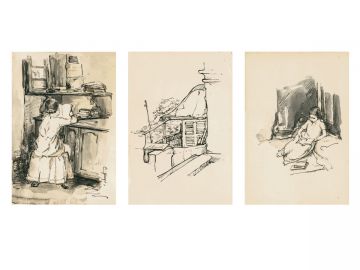Curtain call: Cinema's old-world charm
There was a time when going to the movies was not just about what was on the silver screen. It was an experience that included long queues in front of theatres with ornate facades and regal interiors, hoping for last-minute deals with ticket black marketers, and shows that would run for months on end. As movie screens shrink into the palms of our hands, we revisit some of these iconic venues in Bengaluru, Chennai, Delhi, Kolkata and Mumbai for a glimpse of what silver screens were really meant to be
-
Published:
-
15/12/2018 12:00 AM
MUMBAI: The side entrance of Imperial Cinema, on Lamington Road, has these magnificent elephants holding up an archway. Started in 1905, it now runs Bhojpuri movies with tickets that cost Rs 35 to Rs 40.
MUMBAI: The lobby of Naaz Cinema, on Lamington Road, has overhead lights resembling those used on film sets. The owner, Ramprakash Anand (85), says that in 1951 it was only one of two air-conditioned cinema halls in Mumbai, the other being Liberty at Marine Lines
MUMBAI: New Roshan Talkies on Grant Road mostly screens reruns of old blockbuster Hindi movies
Image by : P Ravikumar for Forbes India
4/19
Image by : P Ravikumar for Forbes India
4/19
CHENNAI: Agastya Theatre, a landmark in Tondiarpet, opened in 1967 as the first 70 mm screen in north Chennai. In its earlier days it screened both English and Tamil films, and now runs the latest Tamil movies and hit Hindi movies
Image by : P Ravikumar for Forbes India
5/19
Image by : P Ravikumar for Forbes India
5/19
CHENNAI: Batcha theatre (once popular as Minerva), on Davidson Street, completed 100 years in 2016. The theatre is currently being renovated and may reopen early next year.
Image by : P Ravikumar for Forbes India
6/19
Image by : P Ravikumar for Forbes India
6/19
CHENNAI: The 77-year-old Casino Theatre in Annasalai, which started as a venue for plays, now screens only Telugu films. Earlier, however, it screened predominantly English films.
Image by : P Ravikumar for Forbes India
7/19
Image by : P Ravikumar for Forbes India
7/19
CHENNAI: The red-and-black mosaic tiles of the lobby, of the 77-year-old Casino Theatre in Annasalai
Image by : Subrata Biswas for Forbes India
8/19
Image by : Subrata Biswas for Forbes India
8/19
KOLKATA: Built in 1883, Star Theatre was a venue for plays and was originally located on Beadon Street; it is now on Bidhan Sarani. It was one of the first places to screen motion pictures in Kolkata. Even now plays are staged here at least twice a week.
Image by : Subrata Biswas for Forbes India
9/19
Image by : Subrata Biswas for Forbes India
9/19
KOLKATA: Minerva Theatre was built in 1893 as a venue for plays and staged William Shakespeare’s Macbeth as its maiden production
Image by : Subrata Biswas for Forbes India
10/19
Image by : Subrata Biswas for Forbes India
10/19
KOLKATA: Mitra Cinema on Bidhan Sarani is 87 years old, and started with the screening of Dena Paona, the first film from New Theatre studio. In 1963 the cinema was bought over by Hemonta Krishna Mitra and renamed after the family name
Image by : Nishal Lama for Forbes India
11/19
Image by : Nishal Lama for Forbes India
11/19
BENGALURU: The Vijayalakshmi Theatre in Mahadevpura has stopped screening movies for the past five years. In its better days, this single-screen theatre showed English films, with the 1969 Gregory Peck and Omar Sharif-starrer Mackenna’s Gold being one of its hits. The theatre will soon be demolished
Image by : Nishal Lama for Forbes India
12/19
Image by : Nishal Lama for Forbes India
12/19
BENGALURU: Inside Sandeep Theatre at Shivaji Nagar stand rows of numbered cases meant to hold celluloid reels
Image by : Nishal Lama for Forbes India
13/19
Image by : Nishal Lama for Forbes India
13/19
BENGALURU: Movieland, the 70-year-old theatre in Gandhi Nagar, is one of the last few surviving single screens and still manages to run house-full shows sometimes. It mostly screens Telegu movies
Image by : Nishal Lama for Forbes India
14/19
Image by : Nishal Lama for Forbes India
14/19
BENGALURU: Inside the box-office at Movieland
Image by : Madhu Kapparath
15/19
Image by : Madhu Kapparath
15/19
DELHI: Shiela Cinema in Paharganj was the first cinema hall in the country to have a 70 mm screen. It is one of the biggest single screen venues, with a seating capacity of 980.
Image by : Madhu Kapparath
16/19
Image by : Madhu Kapparath
16/19
DELHI Known for its trendy interiors, Shiela was often visited by Amitabh Bachchan for the premiere of his films. Built in 1961, it was designed by leading American architect Ben Schlanger in the modernist style
Image by : Madhu Kapparath
17/19
Image by : Madhu Kapparath
17/19
DELHI: Raj Cinema, in Gurugram, opened in 1953 and still sports hard wooden seats and a screen that runs on a projector. The reels at Raj Cinema are often old and brittle, and tend to snap. The projectionist Raj Kumar has the job of splicing them and keeping them running.
Image by : Madhu Kapparath
18/19
Image by : Madhu Kapparath
18/19
DELHI: Barely surviving, each show at Raj Cinema sees merely a handful of cinemagoers
Image by : Madhu Kapparath
19/19
Image by : Madhu Kapparath
19/19
DELHI: Liberty Cinema in Karol Bagh is where Hema Malini once sat among the audience, dressed in a burqa. It’s also where Govinda jumped onto the stage and danced before the audience. Opened in 1956, the venue has seen years of action, but like other single screens it now attracts a dwindling audience





